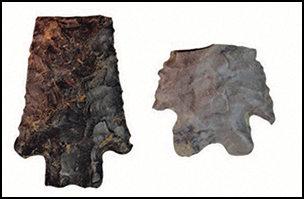Crossref Citations
This article has been cited by the following publications. This list is generated based on data provided by
Crossref.
Eren, Metin I.
Bebber, Michelle R.
Norris, James D.
Perrone, Alyssa
Rutkoski, Ashley
Wilson, Michael
and
Raghanti, Mary Ann
2019.
Experimental replication shows knives manufactured from frozen human feces do not work.
Journal of Archaeological Science: Reports,
Vol. 27,
Issue. ,
p.
102002.
Lombard, Marlize
Lotter, Matt G.
van der Walt, Jaco
and
Caruana, Matthew V.
2021.
The Keimoes kite landscape of the trans-Gariep, South Africa.
Archaeological and Anthropological Sciences,
Vol. 13,
Issue. 6,
Smith, Heather N.
Perrone, Alyssa
Wilson, Michael
Raghanti, Mary Ann
Lovejoy, C. Owen
Rosen, Merri J.
Shanbhag, Sharad J.
DeForrest, David S.
Lyman, R. Lee
and
Eren, Metin I.
2021.
Rock Music: An Auditory Assessment of Knapping.
Lithic Technology,
Vol. 46,
Issue. 4,
p.
320.
Diez-Martin, Fernando
Buchanan, Briggs
Norris, James D.
and
Eren, Metin I.
2021.
Was Welling, Ohio (33-Co-2), a Clovis Basecamp or Lithic Workshop? Employing Experimental Models to Interpret Old Collections.
American Antiquity,
Vol. 86,
Issue. 1,
p.
183.
Bebber, Michelle R.
2021.
The Role of Functional Efficiency in the Decline of North America’s Copper Culture (8000–3000 BP): an Experimental, Ecological, and Evolutionary Approach.
Journal of Archaeological Method and Theory,
Vol. 28,
Issue. 4,
p.
1224.
Leone, Karen L.
Lepper, Bradley T.
Eren, Metin I.
and
Pansing, Linda L.
2022.
Late Holocene radiocarbon dates for the Welling site (33CS441): A multi-component site in Coshocton County, Ohio.
Journal of Archaeological Science: Reports,
Vol. 41,
Issue. ,
p.
103345.
Lewis, Angela R.
Williams, Jeremy C.
Buchanan, Briggs
Walker, Robert S.
Eren, Metin I.
and
Bebber, Michelle R.
2022.
Knapping quality of local versus exotic Upper Mercer chert (Ohio, USA) during the Holocene.
Geoarchaeology,
Vol. 37,
Issue. 3,
p.
486.
Lewis, Angela R.
Simone, Diana
Williams, Jeremy
Eren, Metin I.
and
Ortiz, Joseph D.
2022.
Using visible derivative spectroscopy to assess flaked projectile point provenance: Application and preliminary analysis of the welling site, Ohio, U.S.A.
Archaeometry,
Vol. 64,
Issue. 4,
p.
833.
Suga, Eiki
Tsukada, Kazuhiro
Tarawneh, Oday
Massadeh, Sate
and
Kadowaki, Seiji
2023.
Explaining the Increase in “High-quality Chert” in the Early Upper Paleolithic Artifacts in Southern Jordan: Quantitative Examination of Chert Mechanical Properties and Fracture Predictability.
Journal of Paleolithic Archaeology,
Vol. 6,
Issue. 1,
Gala, Nicholas
Lycett, Stephen J.
Bebber, Michelle R.
and
Eren, Metin I.
2023.
The Injury Costs of Knapping.
American Antiquity,
Vol. 88,
Issue. 3,
p.
283.
Eren, Metin I.
Diez-Martin, Fernando
Tarriño, Antonio
Smith, Heather
Buchanan, Briggs
Miller, G. Logan
Boulanger, Matthew
and
Slobodin, Sergei
2023.
Toolstone characterization, description, morphometrics, and microwear of a lithic sample from Uptar, Magadan Oblast, Northeastern Siberia, Russia.
Archaeological Research in Asia,
Vol. 35,
Issue. ,
p.
100465.
Suga, Eiki
2024.
The fracture predictability of lithic raw material: A review of archaeological examination into measurement of mechanical properties and geological analysis of rock structure.
The Quaternary Research (Daiyonki-Kenkyu),
Vol. 63,
Issue. 4,
p.
215.
Mukusha, Lawrence
Logan Miller, G.
Smith, Andrew
Bebber, Michelle R.
Spurlock, Linda
Gerrath, John A.
Ortiz, Joseph D.
Wilson, Michael
Buchanan, Briggs
Boulanger, Matthew T.
Eren, Metin I.
and
Meltzer, David J.
2024.
Hit or miss: Do microscopic linear impact traces (MLITs) form on Clovis stone tips launched via atlatl into foliage and sediment?.
Journal of Archaeological Science: Reports,
Vol. 55,
Issue. ,
p.
104517.
Eren, Metin I.
Bebber, Michelle R.
Singer, David
Pearson, Chloe
Ortiz, Joseph D.
Buchanan, Briggs
Beshkani, Amir
Chlachula, Dominik
Dellmour, Rudolf
Garba, Roman
Marks, Anthony E.
Usyk, Vitaly
and
Rose, Jeffrey I.
2025.
Examining the distribution of Middle Paleolithic Nubian cores relative to chert quality in southern (Nejd, Dhofar) and south‐central (Duqm, Al Wusta) Oman.
Geoarchaeology,
Vol. 40,
Issue. 1,
Buchanan, Briggs
Gala, Nicholas
and
Hamilton, Marcus J.
2025.
The Functional Use of Quartz Crystal Points in Clovis Technology.
Lithic Technology,
p.
1.
Paixão, Eduardo
Gossa, Tegenu
Gneisinger, Walter
Marreiros, João
Tholen, Sören
Calandra, Ivan
Hovers, Erella
and
Spinapolice, Enza Elena
2025.
Exploring early Acheulian technological decision-making: A controlled experimental approach to raw material selection for percussive artifacts in Melka Wakena, Ethiopia.
PLOS ONE,
Vol. 20,
Issue. 1,
p.
e0314039.



